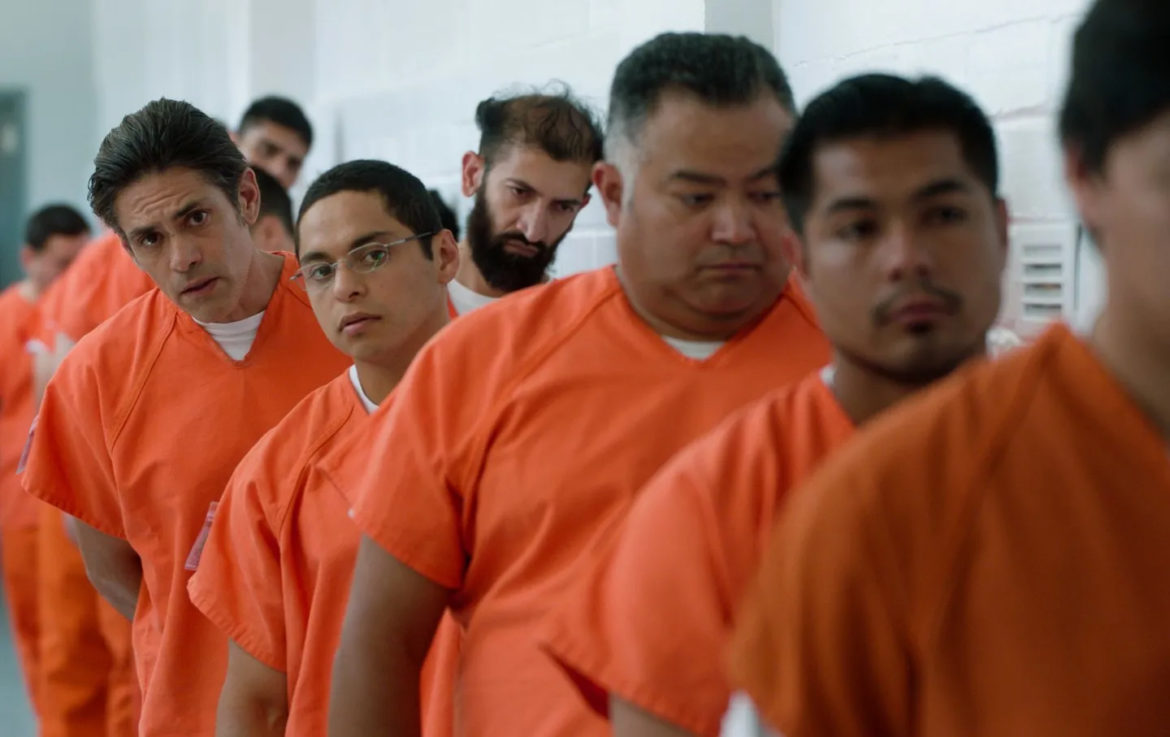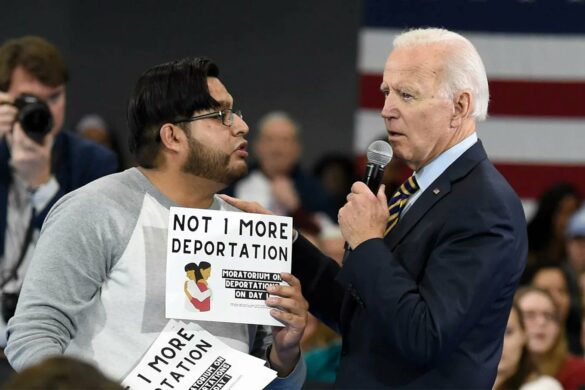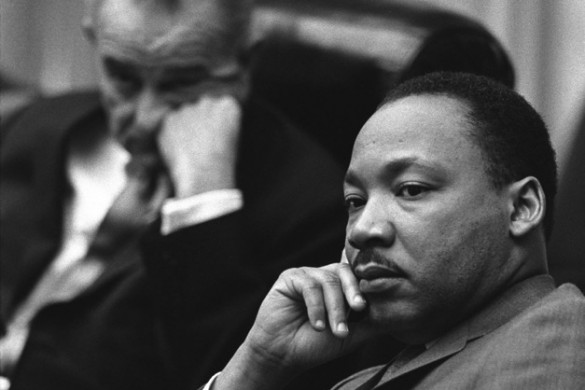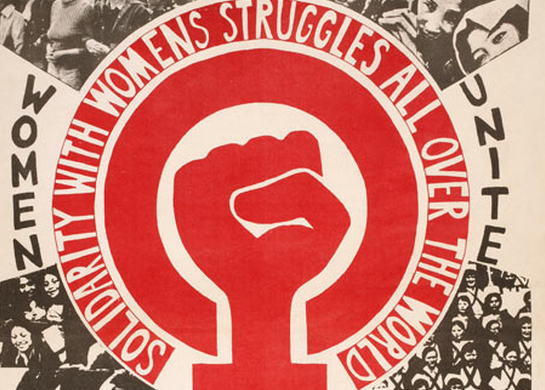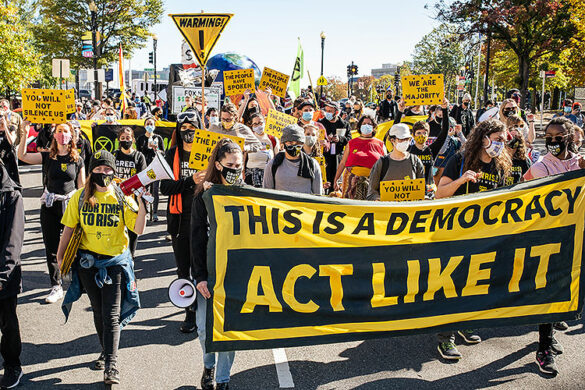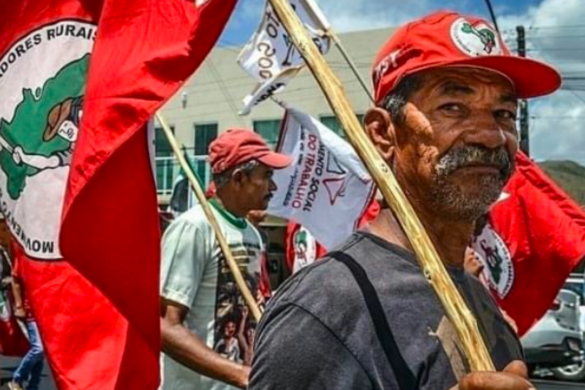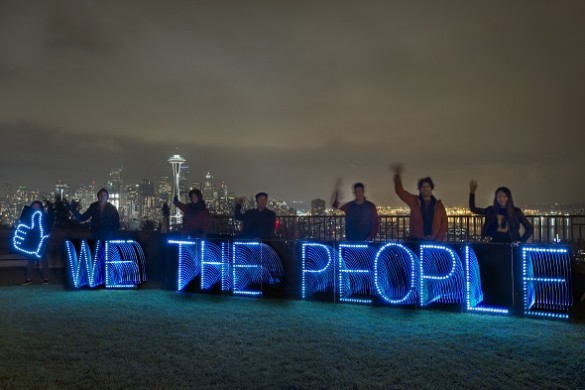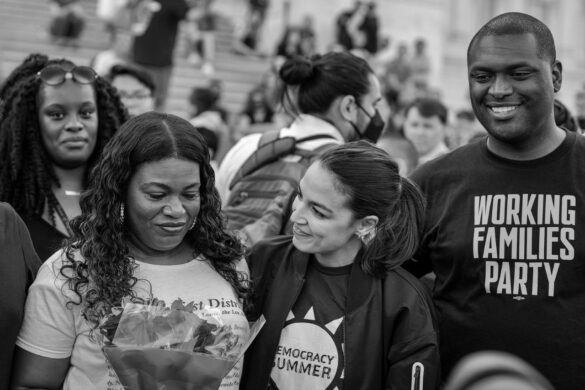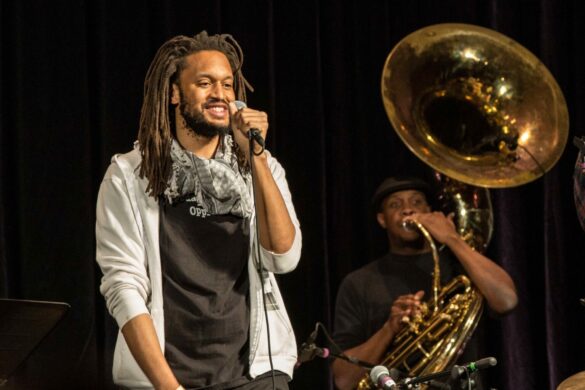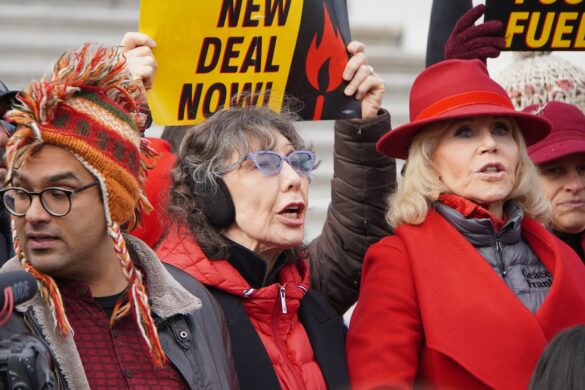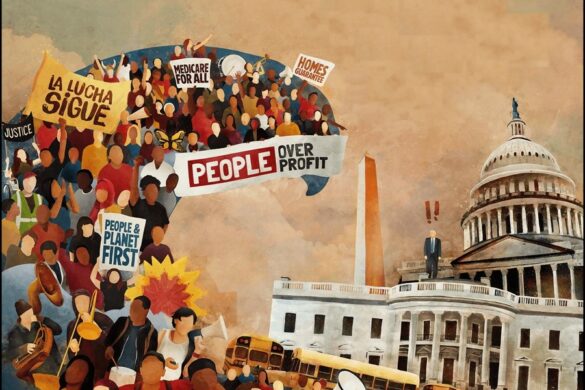A conversation with directors Cristina Ibarra and Alex Rivera about their new film, The Infiltrators.
By Mark Engler
(Published in The Nation)
In 2012, two undocumented youths deployed one of the riskiest and most counterintuitive tactics in recent social movement history: They intentionally got themselves arrested by Immigration and Customs Enforcement (ICE). Although they were in danger of deportation themselves, Marco Saavedra and Viridiana Martinez—supported by a grassroots group called the National Immigrant Youth Alliance—were able to get themselves placed in the government’s Broward Transitional Center in Florida, where they quickly began working to organize the detainees.
At a time when the Obama administration claimed that it was not deporting individuals without criminal records, the activist “infiltrators” proved that this was a lie. Once in the Broward facility, Saavedra and Martinez gathered information and started to publicize the cases of those who were being processed for removal from the country. Despite the White House’s stated intentions, these cases included people pulled from their families and livelihoods because of minor traffic infractions, individuals arrested for driving with an expired license, and women detained when reporting domestic violence to the authorities. These people were held, sometimes for years, without trial or due process. Yet the National Immigrant Youth Alliance showed that, by shining a light on the system’s abuses, it could sometimes stop deportations and secure the release of detainees.
A new film by directors Cristina Ibarra and Alex Rivera explores this audacious campaign. In telling the story of an action they have likened to a “prison break in reverse,” the filmmakers make use of an innovative blend of film genres, combining original interviews, documentary footage of the group’s organizing, scripted reenactment, and elements of a heist thriller. Having won the Audience Award at last year’s Sundance Film Festival, The Infiltrators is now going into general release. Although its theatrical rollout was delayed by the coronavirus pandemic, it will be made available for on-line streaming on June 2.
I spoke with the filmmakers to discuss the tactic of infiltrating ICE, how it fit within a wide range of organizing among undocumented youth during the Obama era, and its implications for today. Our conversation has been edited for length and clarity.
* * * * *
Mark Engler: The idea of infiltrating ICE seems so counterintuitive. A character in the film says, “The one thing that every undocumented kid is told is, ‘If you see a police officer, run and hide, because you could get turned over to immigration.’ What we learned is that, to actually have power as an immigrant, you have to do the exact opposite.” Could you talk a little bit about the logic of this action?
Alex Rivera: What was fascinating was the process of seeing folks who were told by this system that they should disappear and that they didn’t have rights—folks who were part of communities that were living in the shadows—decide to assert their presence and try to become highly visible. Because they saw there was no way to find political power by hiding in the shadows.
And so this group, the National Immigrant Youth Alliance, took a series of steps to come out of the shadows. At first, it was in small ways—just having people say out loud or say online, “I am undocumented.” Then they started to really light things up by sitting in the streets and getting arrested. They found that in the Obama era, there was this little space of possibility for doing these kinds of radical acts of protest that made them highly visible. And once that little aperture was discovered, they proceeded to rip it open bigger and bigger, until they decided, “Well, since we think we won’t get deported, we can go into detention and help get people out.”
Cristina Ibarra: The government was very public about its priorities for deportation. At the time, there was a phrase that you would hear a lot: “We deport felons, not families.” So the activists were putting them at their word, saying, “OK, if that’s true, you shouldn’t be deporting people like us.”
Rivera: They got a call from a family whose father—his name was Claudio Rojas—was in the Broward Detention Center. Claudio called out and said, “This detention center is filled with 700 people who have no criminal records.” The entire Broward County detention center was filled with non-criminal immigrants in 2010, 2011, 2012, during the Obama years, when he was saying, “We’re deporting felons, not families”—which is a ridiculous phrase, because felons have families. But the Broward facility was kind of like the red blinking light of the contradiction of the system. So these students, young DREAMer-type activists, threw themselves at the system to highlight that contradiction. And from there they tried to go to the media and wage an information war to show the hypocrisy of the administration.
Engler: One thing that’s interesting is that this wave of deportations was not happening with a Republican in the White House. This was taking place under Obama. What do you think is the significance of that?
Rivera: For me, the significance is that there is a shortage of political vision and imagination around what justice for immigrants looks like. Under Obama, there was a president who said beautiful things about immigrants and American history, but he was unable to implement any kind of agenda that brought real justice and dignity and freedom to immigrant people. The detention system swelled. If you’re an immigrant in detention, you don’t have the right to counsel, even if you’re 3 or 4 years old. And under Obama, the administration fought against attempts to try to get counsel provided to children in detention. Why the administration handled itself that way back then, we may never know, but we know it did.
To me, one of the things that was so wonderful about spending time with these activists was that they were trying to carve out a kind of alternate imagination, a vision of true freedom for immigrants. Watching this group of young people challenge each other to go into the detention system, to turn it upside down, it seemed like they were on a path to finding a kind of freedom that is so outside of the bounds of the typical conversation about immigration.
Ibarra: I also think it is significant to look at where we are now [with the detention and deportation of immigrants] and see that this was built up before the current administration. The tools that are being used today have been used in the past, but they were under the radar.
Engler: The film conveys a really interesting sense of power that these young activists have. The slogan they chant is, “Undocumented and unafraid!” And there’s not only a fearlessness in what they’re doing, but a sense that ICE and these government agencies are actually going to fear them—that the system is going to fear people standing up and making noise. It’s a striking reversal.
Rivera: Absolutely. There have been very few films, true or otherwise, about breaking in to jail—and that’s essentially what we saw. There was a community of thinkers and activists who had an analysis of a system that led to this moment where they could go through the looking glass see the detention center as a site of the system’s vulnerability.
Engler: How did these infiltration actions fit in a wider timeline of activism around immigrant rights? How did they relate, say, with the mass protests we saw in 2006, or with organizing for the DREAM Act?
Rivera: We met the activists around 2010, and they were just coming out of the failed attempt to pass the DREAM Act in Congress. The undocumented youth who had been pushing for it splintered, and one splinter group turned to civil disobedience. Around 2010, four undocumented youth got themselves arrested in Senator McCain’s office in Arizona and faced their own deportation as a consequence. Nobody knew what would happen. They were held for a few days, and then the system kind of hiccupped them out. They still had ongoing cases, but they were not sent to detention and were not deported. Then after that, they did another arrest, with more people, then another one, then another.
Through this process, the National Immigrant Youth Alliance was escalating and pushing the envelope. They went to places like Alabama to intentionally test this theory that you can be safe if you do this kind of protest. It worked, and the movement grew over those years. When they did the infiltration, they were at the height of their power.
Ibarra: The idea of [undocumented protesters intentionally] getting arrested started out as a very controversial tactic. It wasn’t really widely accepted. These were the radical activists getting themselves detained, and they were critiqued for it. But then it worked, and it kept working and working. So it became a more mainstream tactic.
Engler: Under Obama, the administration is building up this massive enforcement infrastructure, but then there’s also a way in which the White House could maybe be pushed. It seems like there was some push and pull with politicians.
Rivera: At various levels of elected officials, that was exactly the dynamic. The activists were always targeting the Democrats. They were targeting the politicians who were saying nice things about immigrant communities, then sitting on the sidelines as the detention system mushroomed all across the country. The protests were almost always targeting those officials to see if they could cash the check of the rhetoric. They found that, time and again, they had to fight like hell, but they could get a politician to release a person here and there. So the picture of the immigration enforcement apparatus under Obama through those years is complicated: It’s one of incredible growth and hundreds of thousands of broken families, but if you could get someone on TV, you could get them free.
Ibarra: You could shame the administration into setting them free.
Rivera: But the whole thing highlights the sadness of that time period. You had this administration with a kind of master poet at the top; he’s speaking beautifully about immigration, and yet there’s this draconian system running out of control and growing underneath him. It also highlights how much the concept of discretion plays in this system. The immigration enforcement system is different than the criminal justice system. There’s not a trial with a jury and all that. It’s really driven based on whomever the administration wants to target for enforcement.
In the case of the Rojas family—the main family the activists were helping in the infiltration—they watched their father get swept up one day, locked up for seven months, and then just one day released, because somebody in the administration decided [to let him out.] The idea that the system is driven by this power of discretion—that the decisions are based on someone’s political whims—is pretty terrifying, but it also made it vulnerable to this kind of activism.
Ibarra: And that’s one of the thing that I find so exciting about looking at this activism. From the outside, it might look a little impulsive. But when you really look at what they’re doing, they’re sophisticated political strategists. These are folks who we’re normally seeing in dominant media representations as victims, but in this case we have undocumented activists who know the system and they know how to do this inside-and-outside push. They find the pressure points within the immigration system. They know what local offices to call, or when to get a politician involved, or what politician is most vulnerable. They’re chess players.
Engler: There is a real sense of protagonism in the film. And it’s not just the youth activists who are coming from the outside; there’s also a hunger strike of detainees in the film. There are lots of images of people who are not just suffering their fates.
Ibarra: A huge motivator for both Alex and myself, as children of immigrants, was to see immigrants in a fuller dimension than what we’re used to seeing. We’re used to seeing a criminal or a victim when we think about immigrants. But here we have people who are leaders, who are able to think through how to solve problems. They’re part of the solution. When we think about this huge humanitarian crisis, we should include the voices of the people who know the most. And who are the most knowledgeable? It’s the undocumented people who have been living here.
Engler: One thing that is distinctive about your film is the combination of documentary footage and reenactment—something that puts it in the category of “docu-fiction” or other hybrid forms. But what really struck me was the amazing amount of material you had from spending time with the young people themselves. Many of the key moments in the film are things you shot live, sitting there with the activists while the events were happening. What sort of a relationship did you have that put you there on the scene as so much of the story was unfolding?
Rivera: We started filming with them during an action that they did here in Los Angeles. This was in the first phase of the civil disobedience, when they were doing sit-ins and getting arrested in the street. We thought we’d make a short film about one of those actions. Then, when we were editing, they went and did something bigger and more interesting. They were escalating. At a certain point we stopped editing and just started to film, and the group went on this two-year trajectory of escalating, even beyond the infiltration. We were filming with them through that whole process.
Ibarra: Once we looked at all the material, we had to decide how to tell the story. We found that the Broward infiltration had a beginning, middle, and end to it. So we framed our story around that one event. We did in-depth interviews. We collected media from the Department of Defense website to show some of the detention centers, and then through a FOIA request we obtained internal government memos and emails that corroborated many parts of what we were learning through our interviews.
Alex draws really well, so he was able to do some storyboards to fill in the black gaps in the story, which were what happened inside detention. We could present them to the infiltrators and to Claudio and get feedback. They were able to do memory workshops with us, and with their bodies viscerally relive some of the scenes that we were showing. So the relationship kept evolving, from being with them during the planning of the infiltration, then reflecting on the infiltration a couple years later, and then really drawing out the part of the story that we couldn’t capture with our camera.
Rivera: We had this challenge that, as much as we filmed with them, when they went into detention, they went to a place we could not film. There was so much of the story we couldn’t perceive with the camera, and so it had to be something else. Would it be animation or just talking heads? We settled on recreation and performance. And once you do that, then you have a script, and you can share it with the person who it’s about and say, “Is this right? How does this look?” The film got much better because of that.
We’re still the directors and we’re still the producers, so there’s always going to be inherent and problematic power dynamics in that. It’s just always there. But it felt great that they could see what we were doing and come into the kitchen and help stir the pot and work together in making this thing.
Engler: Were there other films that you looked to as models?
Ibarra: We looked a little bit at films like The Road to Guantanamo and The Arbor. We looked at Wormwood, American Animals, The Imposter.
Rivera: We looked at this body of recent hybrid films. But honestly—I’ll speak for myself—I’m actually not a fan of the genre. It’s mostly because the films are typically made out of an interview with the main subject, and then they have reenactments that recreate the past, so the whole film ends up feeling something like a flashback.
But because we had observational footage, we could do something different. If on a Monday someone went into detention, we were there following them that Monday; and Tuesday we were there with the people left outside. So we were able to create a film where, instead of using a hybrid language to deal with the past, we’re using it to deal with space. Inside the detention center was the landscape of reenactment, and outside of detention was documentary. In the film, the actors in their recreated space in the detention center might pick up the telephone and call the documentary on the outside. So the two forms are running forward in time; they’re interlaced. It has a different feeling than a lot of hybrid films, which are talking heads plus reenactments of stuff that happened in the past.
Ibarra: We tried to stay true to the present tense feel for each moment, as much as we could.
Engler: There’s a way in which the actors and the real people merge in a funny way, particularly when they’re crossing that line of space between inside and outside. A character might run through that barrier, and all of a sudden, instead of seeing the actor, we are seeing footage of the actual person. It’s sort of disorienting, but it’s really interesting to see.
Ibarra: They’re crossing a border [laughs].
Engler: Alex, something you and I have talked about before is the difficulty of showing social movements on film—creating a sense of collectivity when you have formal confines in film where you need to have central characters and individual story arcs. I wonder how you grappled with this. How did this become a movement film and not just a sort of Mission Impossible or Ocean’s Eleven heist film?
Rivera: Over and over again, as we were learning the story, we were stunned by how poetic the structure of the story was. It did start almost like The A-Team. It started with four or five people who were plotting the infiltration. But by the end, there really was a rebellion inside the detention center, and outside as well, that was bigger. And that was the intention. Their plan was to do old-fashioned organizing: talking to people, winning a small victory, using that victory as propaganda to get other people involved and build trust with the community. That’s the journey of the film.
So from a storytelling point of view, it was wonderful, because we could start with a few people, connect with them, understand them. But then when their action reaches its final stages, they sort of melt away and there is a kind of mass. It was a very successful and instructive campaign of community organizing that happened to take place inside a detention center.
Ibarra: It’s a true story, and that’s enough for me. It’s showing people who are not going to accept the way things are, and it’s an example of how you can be creative in resisting. That doesn’t mean this is the way to do it today. It’s just an example of the kind of fearlessness it takes sometimes to change things.
Engler: Bringing this up to the present: How would you say things have changed under Trump?
Ibarra: We know discretion is a tool that executive power has; we don’t know how it can be used right now in organizing specifically to stop deportations. We know that immigration activists are being targeted for their work. We also know that the alternative to speaking out is silence. So what do we do?
Again, I would like to turn to the people in the film, because they’re the experts. But the situation definitely has changed. We’re living through urgent times, where people are getting killed and getting locked up. It doesn’t seem like there’s an end in sight. And I don’t think the answer is silence.
Rivera: The equation that the infiltrators discovered under Obama was this idea that visibility equals power. The Trump administration is doing everything they can to break that, to invert it, to make visibility equal danger. This creates a real political challenge. But it seems clear to me that a civil rights movement around immigration should be led by immigrants. The National Immigrant Youth Alliance and the infiltrators back in 2012 were an embodiment of that: an undocumented-led rebellion focusing on freedom and dignity for their community. Today, Trump is using the discretionary power he has to focus the enforcement system on precisely the people doing that kind of work. I’m not sure anyone knows how to escape that kind of straitjacket right now.
We hope that the film, because it does take place during the Obama years, really puts out the question of, “What is a left vision of justice for immigrants?” Is it detention centers like the one in Broward, that are nice-looking detention centers, as opposed to Trump’s tent camps in the desert? Is that the vision Democrats offer? Is that the vision that the left offers?
We hope the film puts that question urgently on the table. Because if we don’t have a vision of dignity and freedom and justice for cross-border people and transnational families, our future is going to be created by the people who do have a clear vision. And their vision is of prisons and walls.
Photo credit Oscilloscope Laboratories.

